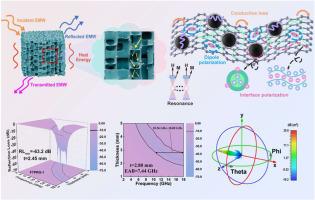合理的Fe3O4@TiO2/PI/rGO气凝胶微纳结构设计,用于集成宽带微波吸收、阻燃和防潮
IF 11.6
2区 材料科学
Q1 CHEMISTRY, PHYSICAL
引用次数: 0
摘要
开发具有强吸收、薄厚度、宽带宽和低填充量的先进电磁波吸收材料来解决日益严重的电磁污染问题仍然是一个重大挑战。本文利用多组分策略,通过定向冷冻和热处理工艺制备了具有三维定向多孔结构的Fe3O4@TiO2/PI/rGO (FTPRG)复合气凝胶。将磁性Fe3O4@TiO2微球引入到PI/rGO框架中,不仅优化了材料的阻抗匹配特性,而且产生了丰富的极化和磁损耗机制,从而增强了电磁波的吸收。值得注意的是,FTPRG-1复合气凝胶具有出色的电磁波吸收性能,在低填充率为5 wt%的情况下,其最小反射损耗(RLmin)为- 63.2 dB,最大有效吸收带宽(EABmax)为7.44 GHz (10.56-18 GHz)。此外,FTPRG-1气凝胶具有中等疏水性、有趣的油水分离能力、阻燃性和绝热性的多功能集成,导热系数为30.6 mW m−1 K−1,显示出作为复杂应用场景的先进EMA材料的巨大潜力。本文章由计算机程序翻译,如有差异,请以英文原文为准。

Rational micro/nano-architecture design of Fe3O4@TiO2/PI/rGO aerogels for integrated broadband microwave absorption, flame retardancy, and moisture resistance
Developing advanced electromagnetic wave absorbing (EMA) materials with strong absorption, thin thickness, broad bandwidth, and low filler loading to address the increasingly severe issue of electromagnetic pollution remains a significant challenge. Herein, leveraging a multi-component strategy, Fe3O4@TiO2/PI/rGO (FTPRG) composite aerogels with a three-dimensional directional porous structure were fabricated through directional freezing and thermal treatment processes. The introduction of magnetic Fe3O4@TiO2 microspheres into the PI/rGO framework not only optimizes the impedance matching characteristics of the material but also generates abundant polarization and magnetic loss mechanisms, thereby enhancing electromagnetic wave absorption. Notably, FTPRG-1 composite aerogel exhibits exceptional electromagnetic wave absorption performance, achieving a minimum reflection loss (RLmin) of −63.2 dB and a maximum effective absorption bandwidth (EABmax) of 7.44 GHz (10.56–18 GHz) at a low filler loading of 5 wt%. Additionally, FTPRG-1 aerogel exhibits multifunctional integration of moderate hydrophobicity, interesting oil-water separation capacity, flame retardancy and thermal insulation with low thermal conductivity of 30.6 mW m−1 K−1, demonstrating promising potential as an advanced EMA material for complex application scenarios.
求助全文
通过发布文献求助,成功后即可免费获取论文全文。
去求助
来源期刊

Carbon
工程技术-材料科学:综合
CiteScore
20.80
自引率
7.30%
发文量
0
审稿时长
23 days
期刊介绍:
The journal Carbon is an international multidisciplinary forum for communicating scientific advances in the field of carbon materials. It reports new findings related to the formation, structure, properties, behaviors, and technological applications of carbons. Carbons are a broad class of ordered or disordered solid phases composed primarily of elemental carbon, including but not limited to carbon black, carbon fibers and filaments, carbon nanotubes, diamond and diamond-like carbon, fullerenes, glassy carbon, graphite, graphene, graphene-oxide, porous carbons, pyrolytic carbon, and other sp2 and non-sp2 hybridized carbon systems. Carbon is the companion title to the open access journal Carbon Trends. Relevant application areas for carbon materials include biology and medicine, catalysis, electronic, optoelectronic, spintronic, high-frequency, and photonic devices, energy storage and conversion systems, environmental applications and water treatment, smart materials and systems, and structural and thermal applications.
 求助内容:
求助内容: 应助结果提醒方式:
应助结果提醒方式:


